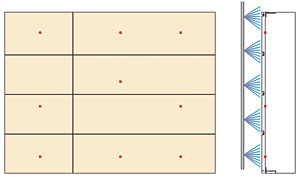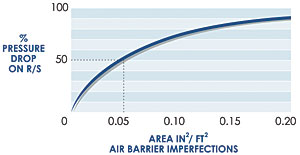Thermal and Moisture Control in Exterior Metal Walls
General Procedures
There are three recognized tests for water and air infiltration:
ASTM E-331 is a static test measuring water infiltration using negative pressure on the interior to pull water through the wall.
AAMA 501.1 is a dynamic test that tries to push water through the wall using applied wind pressure on the exterior.
ASTM − 283 is a static test that uses negative pressure to pull air through the wall.
These tests can be performed using a standard ten foot by ten foot testing chamber for a wall system (Figure 14).
|
Wind Testing
The chart below depicts the equivalent wind speed, pressure,
and water height rise. Most testing is done at very low pressures.
High-performance wall systems are tested at 15-psf pressure
with imperfect air barriers and no water infiltration.
|
|||||||||||||||||||||||||||
Air Barrier Imperfections:
When testing a rainscreen with a 100 percent continuous air
barrier behind the rainscreen, the pressure drop on the outer
wall is zero. However, due to construction
limitations, a perfect air barrier will not be established
on the job site due to penetrations in the wall construction.
There will remain unsealed side joints or improper fasteners
in the barrier. In this test chamber, nine three-quarter inch
diameter holes, which equal five square inches per 100 square
feet, were used to simulate the imperfect barrier. The horizontal
value is the amount of perforation in the air barrier (Figure
17). The vertical value is the percentage of pressure drop
on the rainscreen. With zero imperfections, there is no pressure
drop on the rainscreen. This is really a test of the air barrier,
not the rainscreen. At five square inches per 100 square feet
(the approximate value for unsealed gypsum sheathing) of perforation,
the findings indicated some systems had 50 percent of the
design pressure across the rainscreen. A pressure-equalized
rainscreen will offer enough venting to reduce this percentage
to less than one percent with five square inches per 100 square
feet of air barrier imperfection.
|











